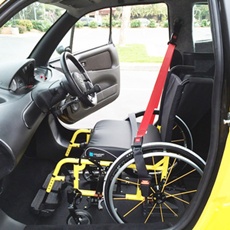Soon, you may drive a car from a wheelchair!
08 Sep 2015
After gathering dust for some six years, the first car that can be driven directly from a wheelchair is in production, and expected to be on the road inside 18 months.
 Kenguru, which is Hungarian for "kangaroo," was founded in Hungary but moved to the US when it struggled to find venture capital – and the push was given by Stacy Zoern, an Austin, Texas lawyer.
Kenguru, which is Hungarian for "kangaroo," was founded in Hungary but moved to the US when it struggled to find venture capital – and the push was given by Stacy Zoern, an Austin, Texas lawyer.
In 2001, Zoern crashed her van beyond repair. It had been customized to accommodate her wheelchair, and it could have cost up to $80,000 to replace. So she stopped driving altogether.
While doing some Google searches a decade later, Zoern discovered the Kenguru (Hungarian for ''kangaroo'' and pronounced the same), an electric vehicle concept specifically designed for people who use wheelchairs. Its creator, Istvan Kissaroslaki, had all but given up on it, as the recession meant a big loan fell through.
Zoern convinced him to move to Texas, and together they found 30 investors and raised the $4 million needed to get the car on the road. And in 12 to 18 months, drivers with disabilities will be able to buy a Kenguru.
The car has no seats. You drive your wheelchair straight into the drivers slot from the rear and drive the car by putting your hands on motorcycle-style handlebars. It's built for wheelchair users, who can roll right through the rear hatch of the car into the driver's area.
The Austin-based company is preparing to launch its first product, which has an estimated range of 60 miles on an eight-hour charge. When it finally goes into production in 12-18 months, the vehicle will cost $25,000, but that's before factoring in green energy and mobility tax incentives from the government.
There is no word yet on the safety credentials of the car, which at 7 feet by 5 feet is even smaller than a smart car. And don't try to overtake anything except a bicycle - the Kenguru only goes 45 kph flat out, and is thus meant for the average trip to the grocery store or down the street to work.
It has only a single door at the rear of the vehicle for direct wheelchair access. It's opened by remote control. Inside the driver is nestled in a 350-kg fiberglass cocoon 2,125 mm long, 1,620 mm wide and 1,525 m (60 in) tall - extremely compact, in other words. Empty weight with the batteries increases to 550 kg.
Power from the batteries is delivered to two 2-kW motors located on the rear axle. These afford a maximum speed of 45 km/h, a range of between 70 and 110 km and a climbing ability limited to 20-per cent gradients - modest, but Kenguru is positioned very much for short inner-city trips. A joystick-controlled version to replace the motorcycle-style handlebars is currently in development.
While the initial launch will be in the US, distribution in a number of European countries should follow. The company, Community Cars, is currently seeking investment through RocketHub to develop the joystick-controlled model.






























